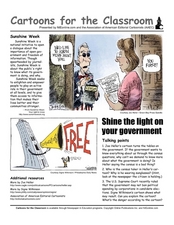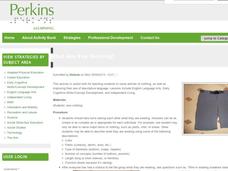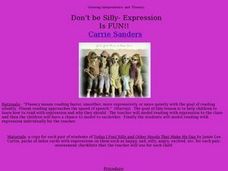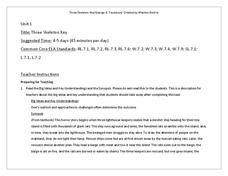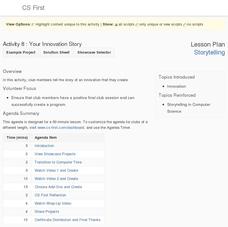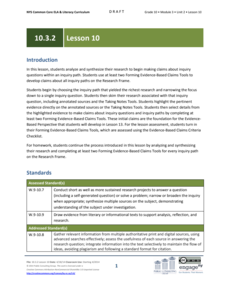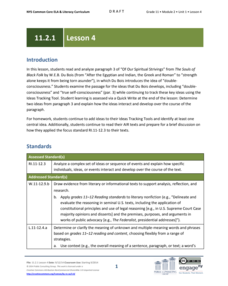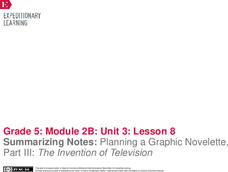Curated OER
Cartoons for the Classroom:
Editorial cartoonists can make a big impact: this political cartoon analysis handout displays 2 cartoons by 2011 Pulitzer-award-winning cartoonist Mike Keefe. Background information gives learners context on the award, and 3 talking...
Curated OER
Cartoons for the Classroom: Shine the Light on Your Government
What don't we know about our government? Explore the concept of transparency and freedom of information throught this analysis handout, in which scholars examine 2 political cartoons. Background information provides context, explaining...
Curated OER
Cartoons for the Classroom: What's Replacing Our Newspapers?
What is happening to print media? Use this political cartoon analysis handout to facilitate pupil exploration of the online-media takeover and the decline of newspapers. Background information gives them context, and 3 talking points...
Curated OER
Cartoons for the Classroom: Campaigns and Gas Pains
Even before they are driving, your scholars have heard the ups and downs of gas prices. Assess the political turmoil behind rising prices using this analysis handout, which features a political cartoon from 2006. Background information...
Perkins School for the Blind
Learning Names of Articles of Clothing
What to wear today; such a vexing question. Spend some time introducing the names, fabrics, types, colors, and functions of various articles of clothing to your class. Each child will take turns asking each other what they are wearing....
PACER Center
The Peer Advocacy Guide
Teasing, mocking, and disrespect can be the hallmarks in the life of those with disabilities. Disrupt the cycle of abuse with a toolkit designed to turn peers into advocates for all those who are bullied. Everything needed to create a...
Curated OER
Introduce a Weather Unit
Engage your learners by playing Water Music Suite by Handel. Different types of weather sounds play on the recording, and it's an easy lead into talking about the weather! What is weather? What kinds of weather exist? What is it called...
Curated OER
Don't Be Silly–Expression is Fun!
As children observe the teacher reading Today I Feel Silly and Other Moods That Make My Day, they take note of the role punctuation plays in the emotion or expression used. They then take turns reading a book with a partner so they can...
Curriculum Corner
“I Can” Common Core! 3rd Grade Reading
Third grade readers are given clear learning goals with this Common Core checklist. By turning each reading standard into an I can statement, children can focus on mastering the required grade level skills.
Washoe County School District
Three Skeleton Key
Conduct a close reading of George G. Toudouze's well-known horror story "Three Skeleton Key." This plan breaks up the reading into several steps and provides text-dependent questions to ask along the way. Learners will have the chance to...
Google
Storytelling: Your Innovation Story
Explore a trailblazing way to talk about innovation. Using the Scratch coding program, young computer scientists create innovations and write stories to accompany them. They include some of the add-ons they mastered throughout the unit.
The New York Times
Writing to Explain: Creating How-To Scripts and Demonstrations
Excuse me, can you give me directions? Scholars examine and practice technical writing to increase their ability to write directions. They participate in discussion, watch videos, and complete an assignment to create their own directions.
Poetry4kids
How to Write an Apology Poem
Put a silly spin on making amends with an apology poem. Budding poets think of a time they were made to apologize although they didn't mean it. They then turn their experience into a poem that offers details and ends with an explanation...
EngageNY
Grade 10 ELA Module 2: Unit 1, Lesson 12
Sticks and stones may break bones, but words matter. Scholars analyze words in paragraphs from Martin Luther King Jr.'s "Letter from Birmingham Jail." They use new vocabulary words and discuss how King's words develop and support his...
EngageNY
Grade 10 ELA Module 2: Unit 1, Lesson 15
Some things are worth doing again. Scholars take a look to see which ideas Martin Luther King Jr. revisits and refines in his "Letter from Birmingham Jail." To help with the process, readers answer guided questions, look at word...
EngageNY
Grade 10 ELA Module 3: Unit 1, Lesson 15
It's time for the grand finale! Scholars finalize their learning in a two-part end-of-unit assessment. This assessment covers multiple standards as learners demonstrate their understanding of the central idea, comprehension, and...
EngageNY
Grade 10 ELA Module 3: Unit 2, Lesson 10
What's the verdict? After finding sources and gathering information, scholars must now make a claim. Learners narrow their focus and refine their inquiry paths before analyzing the information and making a claim about their questioning....
EngageNY
Grade 10 ELA Module 3: Unit 2, Lesson 5
Have you ever argued for the sake of argument? Scholars dig into what makes a compelling argument. They learn to create evidence-based arguments using a teacher-led model. Once finished, they use an evidence-based checklist to guide...
EngageNY
Grade 11 ELA Module 2: Unit 1, Lesson 4
What exactly is consciousness? Readers look at paragraph three of the chapter "Of Our Spiritual Strivings" and discuss how Du Bois introduces the ideas of double consciousness and true self-consciousness. Scholars track the development...
EngageNY
Launching the Novel: Character Analysis of Ha
Scholars receive numbers as they work in groups to read Inside Out & Back Again. The instructor calls out specific numbers for readers to share the group's thoughts. Then, they use a model passage to demonstrate the effective actions...
EngageNY
Analyzing the Main Idea in Video: Understanding the Limbic System
It's time to put on those thinking caps and analyze the brain! Pupils watch a video about teenage brain development, using a note-catcher to capture their thoughts about the main idea. Finally, they select two pieces of information from...
American Museum of Natural History
The Amazing Mundo
Rocks and minerals are great on their own, but they also turn into some pretty amazing stuff! An online lesson explains the different types of materials we get from rocks and minerals, including glass, plastic, and coins. An embedded...
EngageNY
Seeing, Hearing, and Comparing Genres: A Poem and a Letter
One can never be too prepared. Pupils prepare for their upcoming mid-unit assessment by writing their group norms for small group discussions. Additionally, scholars read and listen to a poem, comparing the two experiences using a Venn...
EngageNY
Summarizing Notes: Planning a Graphic Novelette, Part III: The Invention of Television
How did the television change people's lives? Learners consider the question as they complete their storyboards about the invention of the TV, adding visual elements along the way. Then, they participate in a peer review to offer and...

